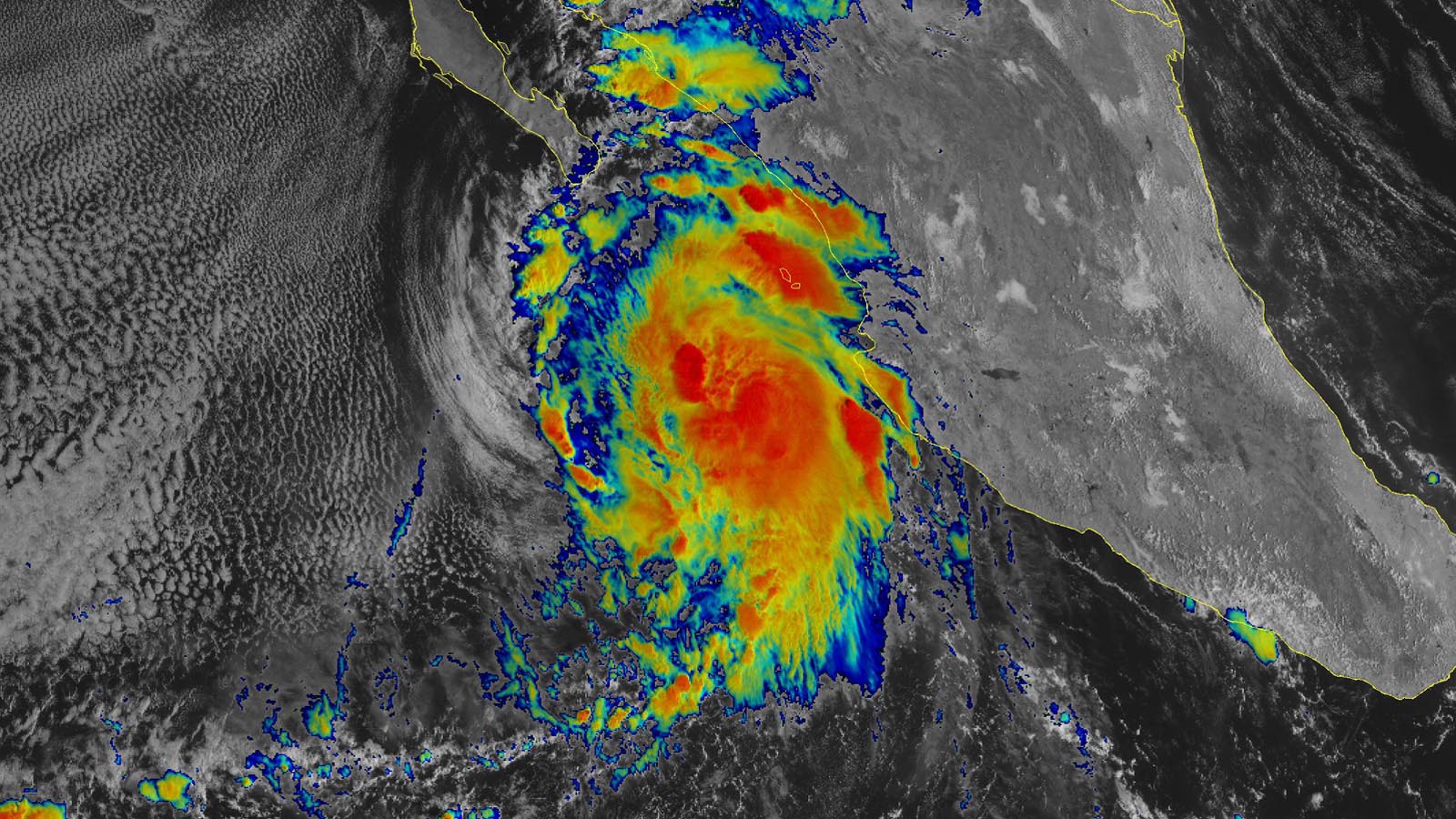A hurricane warning is up for the west-central coast of Mexico as category 1 Hurricane Pamela gathers strength over the unusually warm waters off the Pacific coast of Mexico. Pamela is expected to brush the southern tip of the Baja Peninsula Tuesday night and be at least a category 2 storm when it makes landfall in mainland Mexico Wednesday morning. Moisture from the remnants of Pamela is expected to push into Texas and southeastern Oklahoma on Thursday, bringing rains of three to five inches.
At 11 a.m. EDT Tuesday, Pamela was about 250 miles southwest of Mazatlán, Mexico, headed north at 13 mph, with top winds of 80 mph and a central pressure of 985 mb. Conditions were favorable for development, with moderate wind shear of 10-20 knots and very warm waters near 30 degrees Celsius (86°F). However, Pamela was wrapping dry air from the deserts of Mexico into its circulation, hampering intensification, and partially exposing the low-level center to view at times.
Forecast for Pamela
Pamela is expected to respond to the steering influence of a trough of low pressure passing to its north, recurving to the northeast over the next day, passing well south of the southern tip of the Baja Peninsula on Tuesday night. In its 11 a.m. EDT Tuesday wind probability forecast, the National Hurricane Center gave San Jose del Cabo on the southern tip of Baja just a 6% chance of tropical storm-force winds.
More favorable conditions for intensification are expected Tuesday night through Wednesday morning, when an upper-level wind pattern with lower wind shear is expected to take shape once the hurricane turns northeast. Waters beneath Pamela will warm to a scorching 31 degrees Celsius (88°F) – more than one degree Celsius above average. This ocean warmth results, in large part, from an exceptional heat wave that has brought near-record heat to western Mexico in recent weeks. Warm water along portions of Pamela’s path extend to a substantial depth, with a total ocean heat content of more than 100 kilojoules per square centimeter, a value commonly associated with rapid intensification of hurricanes.
Although this very warm water will favor intensification, Pamela is wrapping a substantial amount of dry air into its circulation, and there may be enough wind shear present to allow that dry air to penetrate the core of the storm and weaken it. Many of the top intensity models show Pamela intensifying to a category 2 or 3 hurricane; category 4 strength is looking unlikely in light of the slower-than-expected intensification of Pamela thus far.
Pamela is predicted to make landfall Wednesday morning within 100 miles of Mazatlán, with NHC’s forecast calling for a category 2 storm with 100 mph winds just before landfall. In its 11 a.m. EDT Tuesday wind probability forecast, NHC gave Mazatlán a 13% chance of receiving hurricane-force winds, and a 94% chance of tropical storm-force winds. Mazatlán has a population of about 500,000.
The first hurricane hunter mission into Pamela entered the storm early Tuesday afternoon.
Southeastern Bahamas disturbance not expected to develop
A tropical wave extending from the eastern Caribbean northward across Hispaniola, the Turks and Caicos Islands, and the southeastern Bahamas was producing a large area of heavy thunderstorms on Tuesday afternoon. The disturbance, which NHC had not yet labeled, was headed north at 5 to 10 mph, and had marginal conditions for development, with high wind shear of 20-35 knots. Satellite images on Tuesday afternoon showed the system poorly organized with little rotation.
The wave has little model support for development and is expected to interact with a front by Friday, which will likely end any development prospects. In its 8 a.m. EDT Tuesday Tropical Weather Outlook, NHC gave the system 2-day and 5-day odds of development of 10%.
A string of autumn severe weather continues
NOAA’s Storm Prediction Center on Monday, October 11, received six tornado reports, all from Illinois, as a sprawling upper low in the western U.S. continued to spawn severe weather. A corridor of more than 40 high-wind reports extended from southern Illinois to western Michigan. Damage from these storms was mostly minor, with no serious injuries reported. Several of the tornadoes emerging from supercell thunderstorms were highly visible on the Illinois prairie.
The frontal system that triggered severe weather on Sunday over the Southern Plains and Monday in the Corn Belt was washing out on Tuesday. A new wave of upper-level energy rotating around the strong upper low will spawn formation of an intense surface low on the central High Plains on Tuesday afternoon and evening. As that surface low and a strong dryline move eastward, intense thunderstorms will emerge along a line from southern Nebraska to northern Texas. The Storm Prediction Center has an enhanced risk of severe weather (the third highest category) in place along this corridor.
Several of the initial storms on Tuesday evening could be supercells packing giant hail and strong tornadoes (rated at least EF2 on the Enhanced Fujita Scale), especially over southwest Kansas, western Oklahoma, and the eastern Oklahoma Panhandle.
Related: https://yaleclimateconnections.org/2021/10/tropical-storm-pamela-a-dangerous-threat-to-mexico/
Website visitors can comment on “Eye on the Storm” posts. Comments are generally open for 30 days from date posted. Sign up to receive email announcements of new postings here. Twitter: @DrJeffMasters and @bhensonweather
Source link


